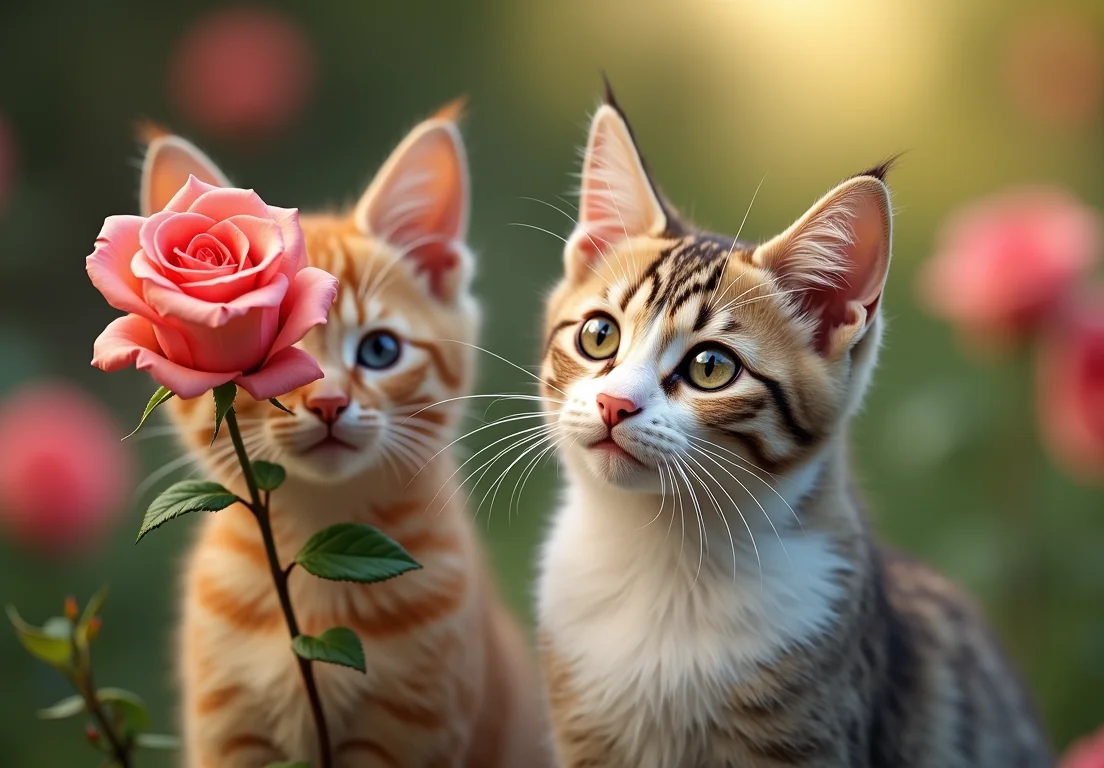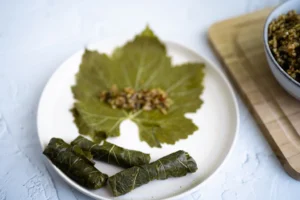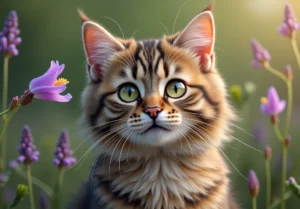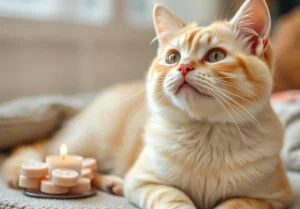Roses are a beloved flower, often gracing our homes or gardens. But if you’re a cat owner, you might wonder if these beautiful blooms pose a hidden danger to your furry friend.
Roses are not considered toxic to cats. While ingesting petals or leaves may cause mild digestive upset, they do not contain harmful substances that would lead to serious health risks. However, there’s more to this than just that simple answer, and we’ve uncovered some important details you’ll want to know about the safety of roses around your pets.

What Parts of the Rose Can Cats Mimic?
Roses may not be classified as toxic to cats, but certain parts of the plant can be quite enticing to our feline friends. Petals, for instance, can attract cats due to their bright colors and soft texture. Some cats may enjoy the scent or simply feel compelled to investigate with their paws and mouths.
The stems, often adorned with sharp thorns, pose a significant risk. Cats may chew on or play with stems, which can lead to cuts in their mouths or paws. Even more concerning, the thorny aspects could cause discomfort if they get stuck.
While leaves might not have the same appeal as petals, a curious kitty might chew on them too. It’s essential to monitor your cat to prevent potential injuries, especially since most cats explore their environment by chewing.
What Are the Symptoms of Ingestion?
If your cat decides to take a nibble on a rose, it’s crucial to know what symptoms to look for. Typically, ingesting roses might lead to mild reactions rather than severe toxicity. Common signs you might observe include:
- Vomiting: This can be the body’s way of clearing out something it shouldn’t have ingested.
- Diarrhea: An upset stomach can lead to loose stools.
- Lethargy: If your cat seems unusually tired or unresponsive, it could indicate discomfort.
Keep an eye on your kitty, especially if they show any of these signs. While it’s rare for roses to cause major health issues, persistent symptoms or any signs of distress warrant a quick call to your veterinarian.
It’s also helpful to be aware of your cat’s personality. Some cats are more prone to gastrointestinal upset, so keep that in mind if yours has a sensitive stomach. Each cat is an individual, and how they react to rose consumption can vary widely.
Are There Other Common Flowers That Are Toxic?
Roses, although beautiful, aren’t on the list of toxic plants for cats. These lovely blooms pose minimal risk if your feline friend decides to take a nibble. However, keeping your kitty safe means being aware of other flourishing plants that can be harmful.
A few common culprits include:
- Lilies: Highly toxic, even a small amount can cause severe kidney damage.
- Azaleas: These can cause vomiting, diarrhea, and even heart issues.
- Tulips: Although not as dangerous as lilies, they can still lead to stomach upset.
- Daffodils: Ingestion can trigger vomiting and diarrhea, and in larger amounts, it can be more serious.
- Oleander: This is incredibly toxic, potentially leading to heart problems.
Always check your plants and flowers to ensure they’re safe for furry companions. Keeping potentially harmful varieties out of reach or opting for cat-friendly alternatives can greatly reduce risks.
How Do Roses Compare With Other Plants?
Compared to many other house and garden plants, roses are among the safer options for cats. While your cat might occasionally munch on rose petals, these blooms generally won’t cause any major health issues. The real concern comes from the thorns, which can lead to minor injuries if your curious cat gets too close.
In contrast, many other plants can have serious effects on your cat’s health. For example, succulents like jade plants and certain varieties of ferns are known to be toxic, causing a range of ailments from digestive issues to lethargy.
Interestingly, some indoor plants, like spider plants, can be safe for cats and even attract their curiosity. These plants often stimulate a cat’s natural urge to chew on greenery, providing an outlet for those instincts without endangering their health.
In essence, while roses might be safe, it’s wise to stay informed about the other plants your cat might encounter. Always research before introducing new greenery into your home or garden to ensure a safe environment for your furry friend.
What to Do If Your Cat Eats a Rose?
Finding out that your cat has nibbled on a rose can be a bit nerve-wracking. Although roses aren’t classified as toxic to cats, it’s still wise to keep an eye on them. Ingesting rose petals or leaves can cause mild gastrointestinal upset, like vomiting or diarrhea. If you suspect your cat has eaten rose parts, here’s what you should do:
Assess the Situation: Look for any signs of distress such as vomiting, lethargy, or unusual behavior. If these signs appear, it’s best to act quickly.
Check for Thorns: If your cat has been chewing on the stem, ensure no thorns are lodged in its mouth or throat. Check the gums and tongue gently.
Contact Your Vet: If your kitty seems off, call your veterinarian for advice, especially if there are any alarming symptoms. They can provide guidance tailored to your pet’s situation.
Induce Vomiting (Only if Directed): Don’t attempt to make your cat vomit unless your veterinarian specifically instructs you to do so. Some substances can cause more harm when vomited.
Monitor and Hydrate: Keep an eye on your cat’s behavior for 24 hours after ingestion. Ensure they have access to fresh water, as hydration is vital.
Being proactive is key. Your vet can give you the best advice to keep your furry friend safe and sound.
What Makes Cats Attracted to Roses?
Curiosity often gets the best of our feline friends, and roses can be particularly enticing. While roses aren’t inherently appealing as a food source for cats, a few factors contribute to their allure:
Scent: The sweet fragrance of roses can attract cats, igniting their instinctual curiosity. This scent triggers their exploratory behavior.
Texture: Cats love to play with different textures. The soft petals might feel interesting to their whiskers, prompting them to investigate further.
Color: Vivid colors like reds and pinks capture attention. Cats can see some colors, which might pique their curiosity even more.
To manage this behavior, consider these strategies:
Plant Deterrents: If you love having roses indoors, think about placing them out of reach. Hanging baskets or high shelves can do the trick.
Provide Alternatives: Opt for cat-friendly plants like catnip or cat grass. This way, your curious kitty has something safe to chew on.
Play Variety: Engage your cat with toys and activities that divert their focus from your floral arrangements. Regular playtime can reduce their urge to explore your plants.
By understanding what draws cats to roses and addressing these aspects, you can enjoy your beautiful blooms while keeping your pet safe.
Recent Findings on Cat Health and Plants
Roses are not considered toxic to cats, according to the ASPCA. While those beautiful blooms can bring vibrancy to your garden, they don’t pose a serious health risk if your cat nibbles on a petal or two. However, keep in mind that some cats might experience mild gastrointestinal upset from ingesting parts of the plant. This could include symptoms like vomiting or diarrhea, which are usually temporary but can be uncomfortable for your feline friend.
More recently, researchers have delved into the effects of various plants, not just roses, on cat health. As pet owners become more aware of indoor plants and their potential risks, studies have spotlighted the importance of providing safe environments for our pets. Plants such as lilies and poinsettias are known to be harmful, making it crucial to keep a lookout for those in homes with curious cats.
If you’re looking to fill your space with greenery, consider opting for cat-safe plants such as spider plants or cat grass to ensure your furry friend stays healthy while still enjoying some natural decor.
Can Roses Deter Cats in Your Garden?
Roses can act as a natural deterrent for cats, thanks to their thorny stems and strong scent. Cats tend to shy away from areas with sharp, prickly plants, which can help keep your garden a peaceful space for both flowers and felines.
By planting roses along the borders of your garden, you might just create a natural barrier that keeps neighborhood cats from trampling through your beds. Additionally, the fragrance of roses can be off-putting for some cats, steering them away.
If you’re also looking into creating a cat-friendly garden, consider combining roses with plants like lavender or rosemary, which are known to repel cats. This not only enhances the beauty of your garden but contributes to a balanced ecosystem where plants can thrive without feline interference.
Incorporating a mix of texture and fragrance can create a harmonious outdoor space that both you and your cats can enjoy, while also safeguarding your cherished blooms.
Alex, a passionate animal lover, has experience in training and understanding animal behavior. As a proud pet parent to two dogs and three cats, he founded AnimalReport.net to share insights from animal experts and expand his knowledge of the animal kingdom.




